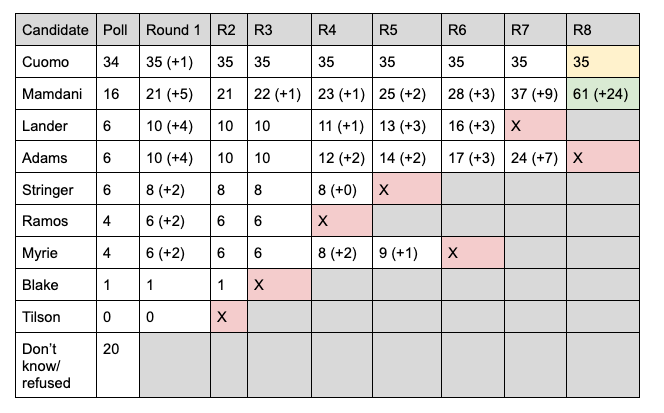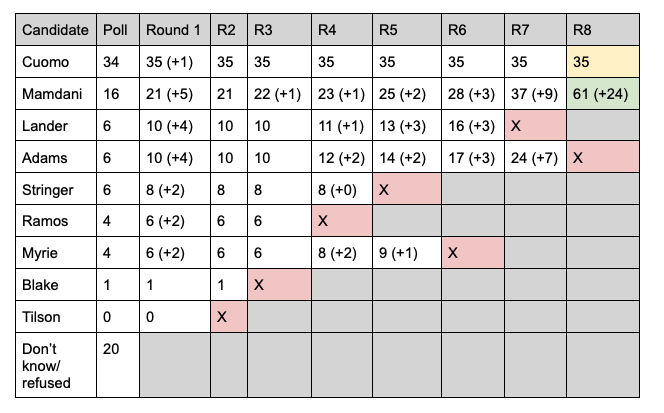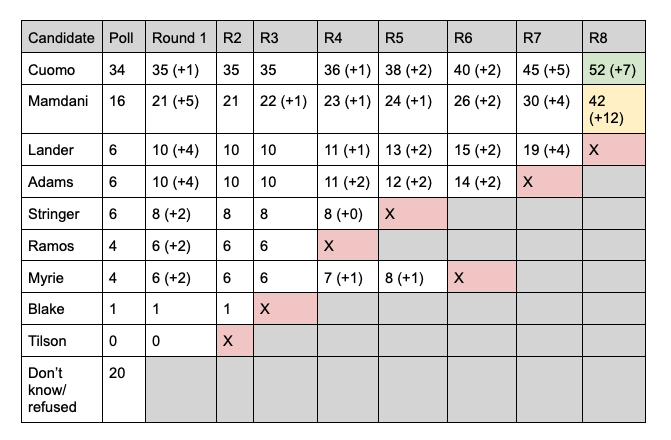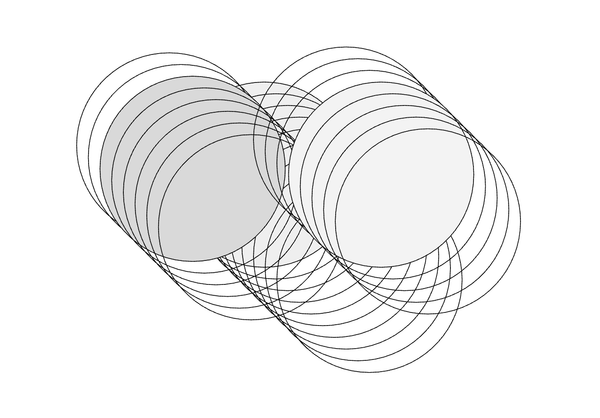NYC must DREAM, but also B-JAZZ
Get me a 5-candidate slate and cross-endorsement, ASAP

How can New York City avoid, yet again, picking a corrupt egomaniacal chauvinist instead of one of the many qualified, progressive, resident mayoral candidates? Ranked choice voting means not only telling voters who not to vote for — it also means giving them a full pack of 5 candidates to rank.
Here’s why.
Let’s take a pretty unfriendly poll as a baseline, the old, small sample Siena/AARP poll from early April. There are 20% of voters who didn’t have a first choice, so we’re going to redistribute these votes following a few assumptions. First, that since Cuomo already has extremely high name recognition and is barely publicly campaigning, it’s unlikely that he will gain a significant portion of currently undecided first choice votes. Second, we will also assume that the Blake and Tilson campaigns are not suddenly going to get a surge of infrastructure and visibility that will afford them many new first choices. The redistribution of these undecideds is shown in parenthesis in the column for Round 1 below.
Ranked choice voting operates in rounds where the lowest candidate is eliminated and those voters’ votes reapportioned to their second choices – this continues for as many rounds are necessary to give a candidate more than 50% of the vote. The DREAM (Don’t Rank Evil Andrew for Mayor) strategy intends to minimize the amount of voteshare that is transferred to Cuomo as less popular candidates are eliminated. If this strategy were to be adopted by 100% of non-Cuomo voters, the election could come out something like this:

*Numbers won’t add up to 100 because we’re rounding and ignoring decimals along the way.
Hooray, Zohran wins! Except, no. It won’t happen this way because we never see 100% compliance with literally any kind of behavior and definitely of the time and definitely not 100% compliance with a voter education scheme in a primary election (no matter of swaggy it is).
What’s much more likely in the status quo is that voters for the progressive candidates do rank Cuomo after their preferred candidates. That wound end up something like this:

Cuomo wins, even as the later progressive votes break more for Mamdani.
How do we prevent this fate from occurring yet again? How can we complement the DREAM strategy with other ways to minimize vote leakage towards Cuomo?
We have to advance strategies that affirmatively tell voters where to put their five ranked choice votes, not just who to ignore. And the sooner we do so, the more time we have to popularize a public anti-Cuomo commonsense.
I see two clear needs on this front. First: we need a five candidate slate. In what I can only describe as an act of criminally negligent strategic malpractice, the New York Working Families Party endorsed a slate of only four candidates (Mamdani, Myrie, Lander, and Adams). In an election where voters are asked to rank 5 candidates – where an organization like WFP expressly exists to challenge the Cuomo faction of the Democratic party – it is bewildering to instruct voters in a way that leaves open a ranking slot for an avowed enemy. The clearest move available for progressive organizations and opinion leaders to promote right now would invite voters to both DREAM and BJAZZ – vote for Brad, Jessica, Adrienne, Zohran, and Zellnor. Like many other endorsements this cycle, I’d run this promote this slate unranked – and like jazz, allow for improvisation and reordering of candidates names in promotion (don’t worry, it doesn’t always have to be an acronym).
Second: we need cross-endorsement as soon as possible. In the last mayoral election, candidates that dropped in the final weeks provided meaningful vote shifts to other candidates by endorsing them (e.g. Yang to Garcia). Not only can we anticipate some progressives may drop out in the next two months, but even if they don’t, voters should be hearing directly and consistently from the (first choice) candidates they trust where their other ranks should go.
Besides the direction of ranked votes to particular progressive candidates instead of Cuomo, adopting these strategies now can help to popularize the idea that everyone, across differences, has a reason to oppose a Cuomo mayoralty. Skeptics may argue that Cuomo will benefit from being perceived as a maverick from the pack. He may try to establish that identity, but in order to do that he’ll at least have to come out of hiding to prove it – and grant opponents an opportunity to expose the reality of his candidacy compared to the COVID TV Show Cuomo that seems to persist in many voters’ minds.
I don’t believe that defeating Cuomo is going to be easy, but I do believe there’s a world where he only loses support from here until election day. That world involves a comprehensive press against his politics and persistent efforts to organize votes to flow in the right direction on election day.
Thanks for reading Empty Brain! Subscribe for free to receive new posts and support my work.



